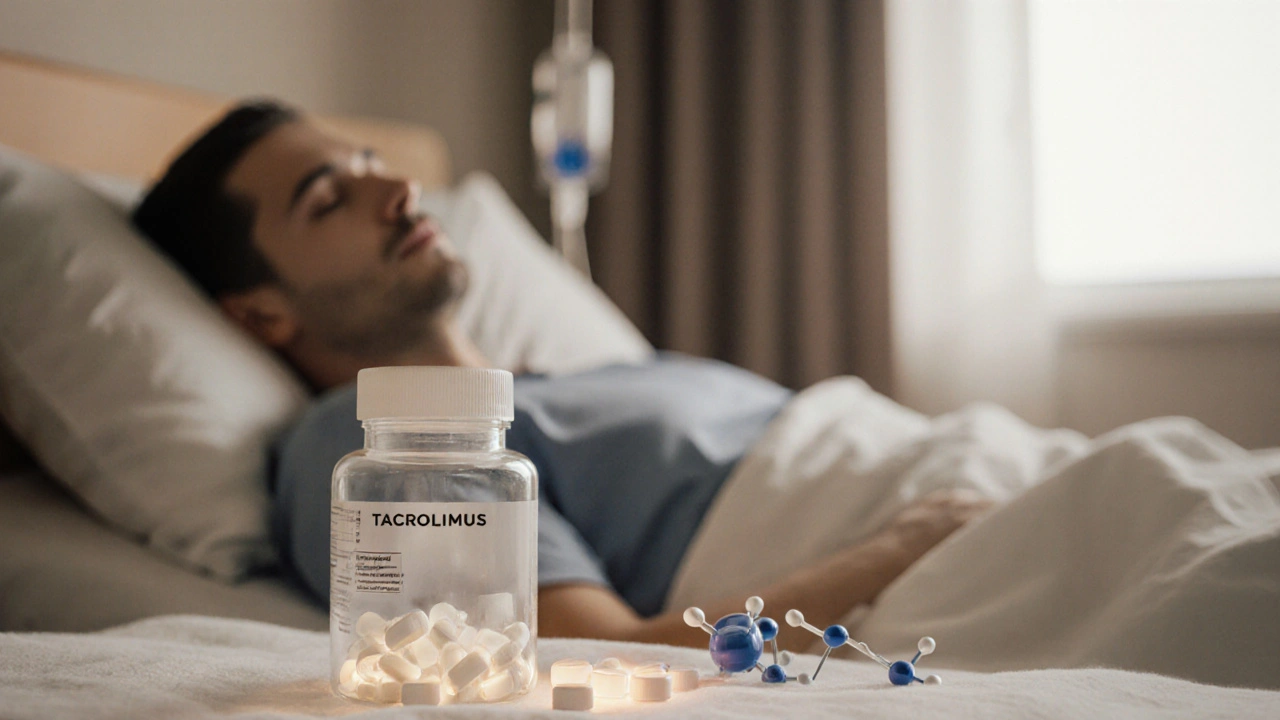Immunosuppressant Selection Tool
Select Your Patient Criteria
Recommended Immunosuppressant
Why this choice?
When it comes to preventing organ rejection after a transplant, Prograf (Tacrolimus) often tops the list, but several other drugs can do the job. Understanding how they stack up helps patients, caregivers, and clinicians pick the right regimen for each situation.
Why Compare Immunosuppressants?
Choosing an immunosuppressant isn’t a one‑size‑fits‑all decision. Factors such as the type of transplant, kidney or liver function, drug‑drug interactions, cost, and personal tolerance all play a role. A side‑by‑side look at the most common alternatives makes it easier to weigh benefits against drawbacks.
Key Comparison Criteria
- Mechanism of action: How the drug stops the immune system from attacking the graft.
- Typical dosing schedule: Frequency and concentration needed to maintain therapeutic levels.
- Efficacy: Success rates in preventing acute rejection.
- Side‑effect profile: Short‑term and long‑term adverse events.
- Drug interactions: Compatibility with other medications the patient may be taking.
- Cost and accessibility: Pricing differences across countries, especially in Australia.
Prograf (Tacrolimus) Overview
Prograf is a calcineurin inhibitor that suppresses T‑cell activation by blocking interleukin‑2 production. It was first approved in 1994 and quickly became a staple for kidney, liver, heart, and lung transplants. Typical oral dosing ranges from 0.1mg/kg to 0.2mg/kg per day, split into two doses, with target blood trough levels of 5-15ng/mL depending on the organ type.
Key advantages include higher potency than older calcineurin inhibitors and a lower incidence of acute rejection in many studies. However, patients often report tremors, nephrotoxicity, and increased blood sugar levels.
Top Alternatives
Cyclosporine
Cyclosporine is also a calcineurin inhibitor, but it binds to cyclophilin instead of FKBP‑12. Doses typically start at 3-5mg/kg per day, divided into two doses, aiming for trough levels of 100-300ng/mL. While effective, cyclosporine is known for gum hyperplasia, hirsutism, and a higher risk of hypertension compared with tacrolimus.
Sirolimus (Rapamycin)
Sirolimus works by inhibiting the mammalian target of rapamycin (mTOR), halting T‑cell proliferation after interleukin‑2 signaling. The usual maintenance dose is 2mg once daily, with target trough levels of 5-15ng/mL. Sirolimus is less nephrotoxic than tacrolimus, making it a good option for patients with pre‑existing kidney issues, but it can cause hyperlipidaemia and delayed wound healing.
Everolimus
Everolimus is a derivative of sirolimus, sharing the mTOR‑inhibition pathway. Dosing is often 0.75mg twice daily, aiming for trough levels of 3-8ng/mL. Benefits include a lower pill burden and similar kidney‑sparing effects, yet it can also raise cholesterol and impair wound healing.
Mycophenolate Mofetil (MMF)
Mycophenolate Mofetil (MMF) blocks inosine monophosphate dehydrogenase, limiting guanine synthesis in lymphocytes. Standard dosing is 1g twice daily. MMF is frequently combined with calcineurin inhibitors to reduce overall toxicity. Common side effects are gastrointestinal upset and bone‑marrow suppression.
Belatacept
Belatacept is a fusion protein that blocks the CD80/86‑CD28 co‑stimulatory signal required for T‑cell activation. It is administered intravenously, usually 10mg/kg on days 0, 14, 30, 60, then every 28days. Belatacept offers a nephro‑protective profile, but its higher cost and need for infusion limit widespread use.
Side‑Effect Profiles at a Glance
- Prograf (Tacrolimus): Tremor, nephrotoxicity, hyperglycaemia, neuropsychiatric effects.
- Cyclosporine: Hypertension, gum overgrowth, hirsutism, nephrotoxicity (similar but slightly less severe).
- Sirolimus: Hyperlipidaemia, delayed wound healing, mouth ulcers.
- Everolimus: Similar to sirolimus, with added risk of proteinuria.
- Mycophenolate Mofetil: Diarrhoea, leukopenia, increased infection risk.
- Belatacept: Infusion‑related reactions, increased risk of post‑transplant lymphoproliferative disorder.

Best‑Fit Scenarios
- Patients with pre‑existing kidney dysfunction: Consider sirolimus, everolimus, or belatacept to spare the kidneys.
- Those struggling with tremor or neuro‑effects: Cyclosporine may be preferred, though it brings its own side‑effects.
- Cost‑sensitive settings (Australia’s PBS): Tacrolimus and cyclosporine are generally subsidised, while belatacept may be prohibitive.
- Need for combination therapy: MMF pairs well with lower doses of tacrolimus or cyclosporine to reduce toxicity.
Quick Comparison Table
| Drug | Mechanism | Typical Dose | Key Advantages | Common Side Effects |
|---|---|---|---|---|
| Prograf (Tacrolimus) | Calcineurin inhibition (FKBP‑12) | 0.1‑0.2mg/kg per day (divided BID) | High potency, lower acute‑rejection rates | Tremor, nephrotoxicity, hyperglycaemia |
| Cyclosporine | Calcineurin inhibition (cyclophilin) | 3‑5mg/kg per day (divided BID) | Long‑track record, similar efficacy | Hypertension, gum hyperplasia, hirsutism |
| Sirolimus | mTOR inhibition | 2mg once daily | Kidney‑sparing, useful in low‑clearance patients | Hyperlipidaemia, delayed wound healing |
| Everolimus | mTOR inhibition (derivative of sirolimus) | 0.75mg twice daily | Lower pill burden, similar kidney protection | Proteinuria, cholesterol rise |
| Mycophenolate Mofetil | Inosine monophosphate dehydrogenase inhibition | 1g BID | Effective when combined, reduces calcineurin dose | GI upset, leukopenia |
| Belatacept | Co‑stimulatory blockade (CD80/86‑CD28) | 10mg/kg IV (monthly after induction) | Nephro‑protective, no calcineurin toxicity | Infusion reactions, PTLD risk |
Frequently Asked Questions
What is the main difference between tacrolimus and cyclosporine?
Both are calcineurin inhibitors, but tacrolimus binds to FKBP‑12 while cyclosporine binds to cyclophilin. This results in tacrolimus having a higher potency and a slightly lower rate of acute rejection, whereas cyclosporine is often associated with gum overgrowth and higher blood‑pressure effects.
Can I switch from Prograf to an mTOR inhibitor like sirolimus?
Switching is possible but must be done under close medical supervision. Because mTOR inhibitors are less nephrotoxic, they are a good option for patients who develop kidney issues on tacrolimus. However, the switch may increase cholesterol levels and delay wound healing, so risks need to be weighed.
Is mycophenolate effective on its own without a calcineurin inhibitor?
Mycophenolate is most effective when used as part of a combination regimen. On its own, the rejection‑prevention rate drops noticeably, which is why clinicians usually pair it with a lower dose of tacrolimus or cyclosporine.
How does belatacept compare cost‑wise in Australia?
Belatacept is considerably more expensive than oral calcineurin inhibitors and is not listed on the Pharmaceutical Benefits Scheme (PBS) for most patients. The need for monthly infusions adds both drug and administration costs, restricting its use to specialised centres or clinical trials.
Which drug has the lowest risk of causing diabetes after transplant?
Tacrolimus is known for a higher incidence of post‑transplant diabetes compared with cyclosporine and mTOR inhibitors. Sirolimus and everolimus have a more neutral effect on glucose metabolism, making them preferable for patients with pre‑existing diabetes risk.


Hey everyone, if you're weighing Tacrolimus against the newer options, think about the patient's kidney function first. Even a modest drop in eGFR can swing the decision toward a kidney‑sparing drug like sirolimus. Also, keep an eye on blood sugar – Tacrolimus tends to push glucose up faster. Stay flexible and adjust doses based on trough levels.
Nice table, but who needs all that detail? 🙄
In reviewing the comparative data, it becomes evident that Tacrolimus offers superior potency relative to Cyclosporine, yet the latter retains a distinct advantage in terms of cost efficiency within many health‑system formularies. The pharmacokinetic profile of Tacrolimus, characterised by a narrower therapeutic window, necessitates diligent therapeutic drug monitoring. Conversely, Sirolimus and Everolimus present reduced nephrotoxicity, which may be paramount for patients with pre‑existing renal compromise. Nonetheless, the heightened incidence of dyslipidaemia associated with mTOR inhibitors warrants vigilant lipid management. Ultimately, the clinician must integrate organ‑specific efficacy, side‑effect spectrum, and patient‑centric considerations into the therapeutic algorithm.
Wow, this whole comparison is like a roadmap for transplant survivors! 🌟 It’s so reassuring to see clear guidance on when to favour a kidney‑sparing agent, especially for folks battling tremors from Tacrolimus. And the cost breakdown for Australian patients really hits home – nobody wants surprise bills after surgery. Keep the practical tips coming, they’re making a huge difference!
Honestly, the table looks like something a pharmacy student drafted after a night of caffeine. Real clinicians know that the subtleties of immunosuppression aren’t captured in simple rows.
Let’s talk about the practical side of switching from Tacrolimus to an mTOR inhibitor. First, you’ll need a wash‑out period to avoid overlapping toxicities. Second, monitor wound healing closely – the delayed closure is a real pain point. Third, keep an eye on cholesterol; you’ll likely need a statin tweak. Lastly, educate the patient about the change in side‑effect profile so they’re not blindsided by mouth ulcers.
The drama of transplant meds never ceases. Tacrolimus may be the star, but the understudies-Cyclosporine, Sirolimus-each have their own tragic flaws. Remember, the cheapest drug isn’t always the hero; sometimes you pay in side‑effects.
Indeed, the cost‑effectiveness of Tacrolimus in Australian PBS schemes is a decisive factor for many centres.
One could argue that the very notion of “best” drug is a philosophical construct, a mirror reflecting our desire for certainty. Yet, the practical world demands decisions, not musings. So, choose wisely and let the data guide you, not the hype.
Here’s a deep dive that pulls together efficacy, safety, and economic angles. First, Tacrolimus remains the gold standard for preventing acute rejection across most organ types, with reported rejection rates often below 10% in the first year. Second, its pharmacodynamics demand tight therapeutic drug monitoring; trough levels should be tailored-5‑15 ng/mL for kidneys, 3‑8 ng/mL for liver-to balance efficacy and toxicity. Third, vigilance is required for nephrotoxicity; studies show a dose‑dependent decline in renal function, especially in patients with baseline impairment. Fourth, the glucose‑raising effect of Tacrolimus is significant-new‑onset diabetes after transplantation (NODAT) can rise up to 25% in high‑risk cohorts, making a case for alternative agents when the diabetic risk is high.
Moving to Cyclosporine, its cost advantage is clear, particularly under PBS subsidies, but its side‑effect profile leans toward hypertension, gum hyperplasia, and hirsutism, which can affect quality of life. Sirolimus and Everolimus, both mTOR inhibitors, shine when renal sparing is paramount. Their hallmark is minimal nephrotoxicity, yet they introduce hyperlipidaemia and delayed wound healing-a trade‑off that surgeons must consider in the immediate postoperative window. Moreover, the combination of an mTOR inhibitor with low‑dose Tacrolimus can achieve synergistic immunosuppression while curbing each drug’s individual toxicity, a strategy supported by recent multicenter trials.
Mycophenolate Mofetil (MMF) is best viewed as an adjunct rather than a primary agent; it reduces the calcineurin inhibitor burden and mitigates some side‑effects, but brings GI upset and bone‑marrow suppression into the equation. Finally, Belatacept offers a nephro‑protective, non‑calcineurin pathway, but its high acquisition cost and requirement for monthly IV infusions limit accessibility outside of academic centers. In resource‑constrained settings, the decision often defaults to Tacrolimus or Cyclosporine, balancing efficacy against affordability.
Bottom line: match the drug’s pharmacologic footprint to the patient’s comorbid canvas. High diabetes risk? Lean toward Cyclosporine or an mTOR inhibitor. Pre‑existing renal insufficiency? Consider Sirolimus/Everolimus or Belatacept if budget permits. Cost‑sensitive environments? Tacrolimus and Cyclosporine remain the workhorses, provided therapeutic drug monitoring is robust.
Wow, look at this ocean of data-so many numbers, so little clarity. It feels like a marketing brochure masquerading as science. Honestly, if you can’t distill it into a one‑liner, you’re missing the point.
Stop pretending this is anything but a cash grab.
Let’s keep the momentum-if you’re on the fence, pick Tacrolimus and monitor closely. The rest will sort itself out.
The grammar in the side‑effect list could use a semicolon here and a period there. Consistency matters for readability.
Too much text, not enough punch.
Overall, the comparison does a solid job laying out the major pros and cons. It’s a useful reference for anyone navigating post‑transplant medication choices.